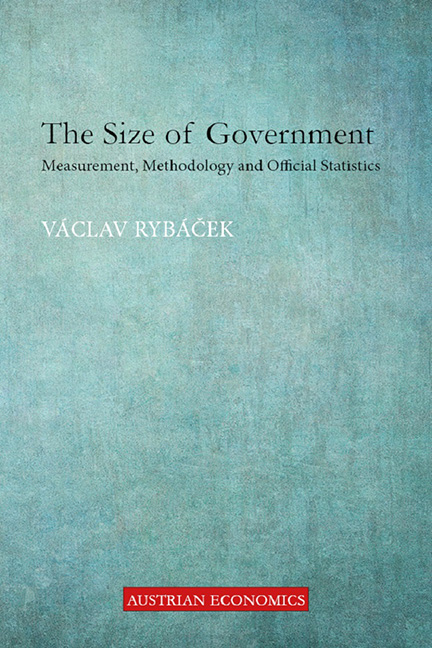Book contents
- Frontmatter
- Contents
- Introduction
- Chapter 1 The Size of Government in Economics
- Chapter 2 The Role of Measuring Government in Economic Policy
- Chapter 3 A Short Trip to the Past
- Chapter 4 The Current Approach
- Chapter 5 What’s Wrong with the Current Approach?
- Chapter 6 The Size of Government and GDP
- Chapter 7 Is the Size of Government Underestimated?
- Chapter 8 Recalculation of the Size of Government
- Conclusion
- Notes
- Bibliography
- Index
Chapter 7 - Is the Size of Government Underestimated?
Published online by Cambridge University Press: 09 August 2023
- Frontmatter
- Contents
- Introduction
- Chapter 1 The Size of Government in Economics
- Chapter 2 The Role of Measuring Government in Economic Policy
- Chapter 3 A Short Trip to the Past
- Chapter 4 The Current Approach
- Chapter 5 What’s Wrong with the Current Approach?
- Chapter 6 The Size of Government and GDP
- Chapter 7 Is the Size of Government Underestimated?
- Chapter 8 Recalculation of the Size of Government
- Conclusion
- Notes
- Bibliography
- Index
Summary
In this chapter, we shall make two steps beyond the conventional methodology. First, we shall extend the coverage of the government sector by including all public institutions as identified by the concept of control in national accounts; second, we will take into the accounts other kinds of expenditures which conventionally fall outside the definition. Government aggregates, recalculated in this way, will then be compared with nominal GDP as it is defined by current methodology.
Before going further, it is worth emphasizing that the analysis below is based, of course, on the currently existing data. Data availability poses, as usual for any empirical analysis, a more or less serious limitation. Simply put, not all useful and required data are reachable. For our purposes, this is mainly the case of public non-financial corporations and some of the central bank’s indicators. Unfortunately, lack of data does not allow us to recalculate all aggregates which would be desirable. Nevertheless, it opens a room for future research, once the missing data is available.
GOVERNMENT EXPENDITURES EXTENDED
First, let’s look at one of the most popular expressions of the size of government, in terms of total government expenditure. Although the designation “total” suggests that the government outlays are recorded in their entirety, this is not the case. Some categories of expenditures are excluded on the grounds that they will generate revenue in the future. In the national accounts terminology, these are categorized as “pure financial transactions”. Certain parts of government outlays thus remain hidden from the aggregate of “total expenditures”; technically speaking, they are identifiable only from the financial account in the system of national accounts, i.e. “below the line” and in the balance sheets. This concerns mainly financial investments in private or public companies through purchases of shares, provisions of loans and bond purchases as well as bond issuances which are not caused by a need to cover excessive expenditures. Despite the presumed recoverability, acquisitions of financial assets constitute, of course, a redistribution favouring one group of fellow citizens at the cost of others.
- Type
- Chapter
- Information
- The Size of GovernmentMeasurement, Methodology and Official Statistics, pp. 129 - 142Publisher: Agenda PublishingPrint publication year: 2019



